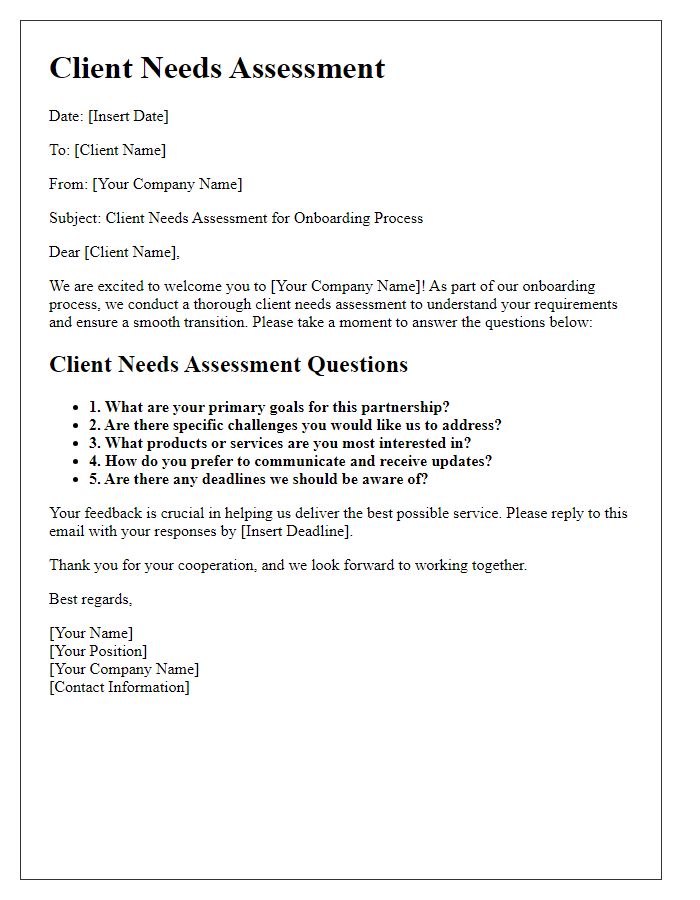Welcome to our community! We're excited to kick off this journey with you, and our client onboarding questionnaire is the first step in getting to know your unique needs and goals. By sharing your insights, you'll help us tailor our services to fit perfectly. So, grab a cup of coffee and let's dive into the details â read on to discover what we have in store for you!

Client Information Gathering
Client onboarding questionnaires are vital for collecting essential information from new clients to tailor services effectively. The questionnaire typically includes various sections, capturing data such as contact details (name, email, phone number), company information (business name, industry, size), and specific service requirements (desired outcomes, budget range). Additional areas may encompass client preferences (communication style, meeting frequency), project timelines (start date, milestone dates), and any previous experiences with similar services (lessons learned, expectations). A well-structured onboarding questionnaire ensures a smooth start to the client relationship, paving the way for customized solutions that meet their unique needs and objectives.
Business Goals and Objectives
A well-structured client onboarding questionnaire can provide critical insights into business goals and objectives. Understanding the client's long-term vision (like achieving a 20% increase in revenue by the end of the fiscal year), short-term priorities (such as launching a new product within six months), and specific metrics (like customer acquisition costs or retention rates) is essential for tailoring services effectively. Key focus areas may include target audience demographics (such as age, location, and interests), market position compared to competitors (both local and national), and overall branding strategy (traditional vs. digital marketing approaches). Clarifying these elements helps establish a robust roadmap for collaboration, ensuring alignment with the client's strategic objectives and enhancing overall effectiveness.
Relevant Financial or Legal Documents
For client onboarding, relevant financial documents include bank statements, tax returns, investment account statements, and credit reports. These documents provide insight into the client's financial situation, including income levels, assets, and liabilities, necessary for assessing risk and suitability for financial products. Legal documents, such as letters of consent, partnership agreements, and estate plans, are essential for understanding the client's legal standings and obligations. Utilization of these documents ensures compliance with regulatory standards, as set forth by agencies such as the Financial Industry Regulatory Authority (FINRA) and the Securities and Exchange Commission (SEC), ultimately allowing for a tailored approach to meet each client's unique needs.
Preferred Communication Methods
Effective client onboarding necessitates understanding preferred communication methods to foster strong relationships. Clients often express preferences for channels such as email, telephone, or instant messaging apps like WhatsApp. For instance, survey results indicate that approximately 72% of clients favor email for formal communications, while 65% prefer texting for quick interactions. Additionally, understanding time zones is critical; clients from New York (Eastern Daylight Time) might not align with those in Los Angeles (Pacific Daylight Time) for meetings. Recognizing these preferences not only enhances engagement but also ensures smoother collaboration throughout the onboarding process.
Service Expectations and Preferences
Client onboarding questionnaires are essential for understanding service expectations and preferences. They typically include sections on communication style, frequency of updates, preferred contact methods (such as email, phone, or messaging apps), and specific goals for the engagement. Additionally, clients might be asked to identify any past experiences that shaped their current expectations, giving insights into what worked well or areas needing improvement. Questions regarding desired outcomes, key performance indicators, and timelines for achieving results are also critical. This information allows service providers to tailor their approach, ensuring alignment with client needs and fostering a successful partnership. Detailed responses can lead to more personalized service delivery, enhancing overall client satisfaction and loyalty.
Letter Template For Client Onboarding Questionnaire Samples
Letter template of client background information request for onboarding.













Comments